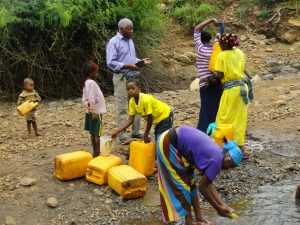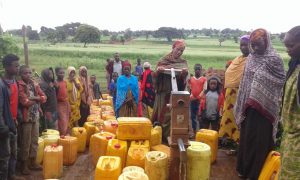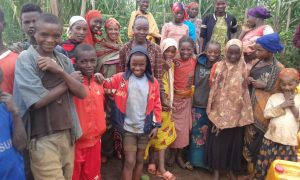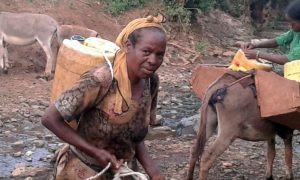This project is made possible through the partnership of WATER CHARITY and the NATIONAL PEACE CORPS ASSOCIATION.![]()
This project has been completed. To read about the conclusion, CLICK HERE.
 Location
Location
Soyama Town, Burji District, SNNPR, Ethiopia
Community Description
Burji District is in the southeast section of Southern Nations, Nationalities, and Peoples’ Region (SNNPR) of Ethiopia. With a population of ~85,000, Burji District is one of the poorest in Ethiopia. The majority of the District citizens are subsistence farmers and small traders.
The District has no paved roads and does not have a reliable running water system. Few of the villagers have a connection to the electricity. There are no hospitals within 100 Km. However, there are five ill-equipped clinics and a few health posts that serve twenty-six villages. The only one high school for the whole district is in Soyama town, which is 26 Km distant from the remotest village.
In the last five years, constant inter-ethnic conflicts with the neighboring much-larger Oromo tribe, Guji, has destroyed the Burji District the economy. The Guji tribe is expanding its territory and taking Burji farmlands by force. The main trading road between the two communities was closed since 2017, squeezing the ability of Burji farmers to sell their products.
At present, two thousand Internally Displaced People (IDP) families that have been forced from their homes in the Oromo region are trying to survive in the Burji District. These families live in tents with no water or sanitation.
 Grow East Africa (GEA), a project of Diaspora Burji Community Organization, is working with a small group of the Burji IDP families by growing nutritional vegetables, teff, and quinoa for food. In 2018, GEA organized the IDP ladies to form a cooperative and registered them as a government certified organization. GEA leased 3.5 hectares of land on an old school ground that has well water.
Grow East Africa (GEA), a project of Diaspora Burji Community Organization, is working with a small group of the Burji IDP families by growing nutritional vegetables, teff, and quinoa for food. In 2018, GEA organized the IDP ladies to form a cooperative and registered them as a government certified organization. GEA leased 3.5 hectares of land on an old school ground that has well water.
On one hectare, GEA installed a drip irrigation system using a new submersible solar pump that replaced the previous hand pump.
Problem Addressed
The villagers and IDP families that surround the GEA property need a reliable source of water. This will allow GEA to continue to develop its property to support the needs of its growing population.
As one of the poorest districts in SNNPR, Burji District lacks the resources for necessary infrastructure development and livelihood improvement of its residents. There is a lack of access to safe water:
1. In Burji District, the majority of the drinking water is from open water. Animals and unhealthy organisms contaminate these water sources. Borehole water sources also contain a high level of minerals and disease organisms.
2. Burji District does not have running water nor a water treatment facility. Less than 10% of the population has access to safe drinking water.
 3. Girls and women travel long distances to collect water. School-age girls spend their time collecting water instead of doing schoolwork. This chore often discourages girls from remaining in school. Similarly, the time spent to collect water from a distance takes away time the women can work on other productive livelihood improvement chores such as working on the farm or taking care of the family.
3. Girls and women travel long distances to collect water. School-age girls spend their time collecting water instead of doing schoolwork. This chore often discourages girls from remaining in school. Similarly, the time spent to collect water from a distance takes away time the women can work on other productive livelihood improvement chores such as working on the farm or taking care of the family.
4. Children and pregnant women are sickened by waterborne Diseases. As a result, children often miss school and finally drop out from continuing in their education.
5. Lack of access to safe drinking water has a direct impact on the poor sanitation at home and schools that lead to illnesses, and negatively impacting childhood development.
Project Description
This project is to develop a solar-powered borehole for the use of the community in a location close to the village and the tent city of the IDP community.
An existing non-functioning borehole will be drilled deeper if needed to ensure an adequate supply of water for years to come.
A pump will be installed, powered by 5 solar panels on a newly-built stand. A 5,000-liter water tank will be installed on a new tower. A piping system will be installed to ensure adequate and appropriate access. Other above-ground improvements will include appropriate fencing and a soak-away system to avoid standing water.
 This community water project is located in Hare Wonjie Kebele, on the eastern outskirts of Soyama town in Burji District, SNNPR Ethiopia. The project involves replacing a hand pump in the current borehole with a submersible solar pump and pumping the water to a storage tank located near the borehole. The water is then further pumped up an incline using a gas-powered pump for a distance of 900 meters to the village for distribution.
This community water project is located in Hare Wonjie Kebele, on the eastern outskirts of Soyama town in Burji District, SNNPR Ethiopia. The project involves replacing a hand pump in the current borehole with a submersible solar pump and pumping the water to a storage tank located near the borehole. The water is then further pumped up an incline using a gas-powered pump for a distance of 900 meters to the village for distribution.
To accomplish this, they have formed the project team consisting of representatives from the village including the village chairperson, Burji District Water Department, Burji Development Association (BDA), Burji District Construction Department and GrowEastAfrica.org team leader. The project team will have the survey and plan developed in conjunction with the Burji District Water Department.
The Team will purchase a submersible solar pump and above ground gas-powered pumps and storage tank. The submersible solar pump will be purchased from Kenya at half the price compared to Ethiopia.
Project Impact
2,000 people will benefit from the project.
Project Administration
The project will be administered by Dr. Yohannes Chonde, Founder of Grow East Africa (GEA), a project of Diaspora Burji Community Organization. GEA will work in collaboration with a local NGO called Burji Development Association and the Burji District Water Department.
Monitoring and Maintenance
WASH training will be given by the GEA team to the whole community before the completion and transfer of the project. The project impact on the village will be measured by conducting series of surveys focused on detectable changes in the health of venerable children, elderly and pregnant women, school attendance, and performance of school-age girls in school and at home.
To ensure the continued and proper use of the facilities, they will check the daily logbooks on the water consumption and conservation, performance of the pumps, frequency of repairs, and downtime. They will also monitor changes in villagers’ attitude towards this easy access to water opportunity and collect their input and recommendations for improvement.
The sustainability of the project depends on the ability of the village water committee to set an affordable fee and ensuring each resident of the village takes the full responsibility to conserve the water and safeguard the equipment. There will be a regular inspection of the pumps and water line. A structure around the solar control box will protect it from damage and unauthorized usage.
The project team will work with the village water committee to develop a sustainable savings plan, a minimum fee per water usage. The village water committee will maintain the pumps using the funds. In collaboration with the district management, the GEA team will sponsor a water-sanitation and hygiene (WASH) training for the villagers.
Let Girls Learn
One of the time-consuming chores for the school-age girls is fetching water from a distant water source. As a result, school-age girls have less time to spend on their school work, and often get to class late or miss it. Locating the water source close to their village or home will allow girls to fetch water and time on their schoolwork quickly.
Moreover, providing a reference for safe drinking water will keep the girls healthy and energetic, allowing them to perform great in the classrooms and at home. Access to safe drinking water also results in proper sanitation and hygiene for the girls.
Project Funding
This project has been funded by a grant from Vanguard Charitable.